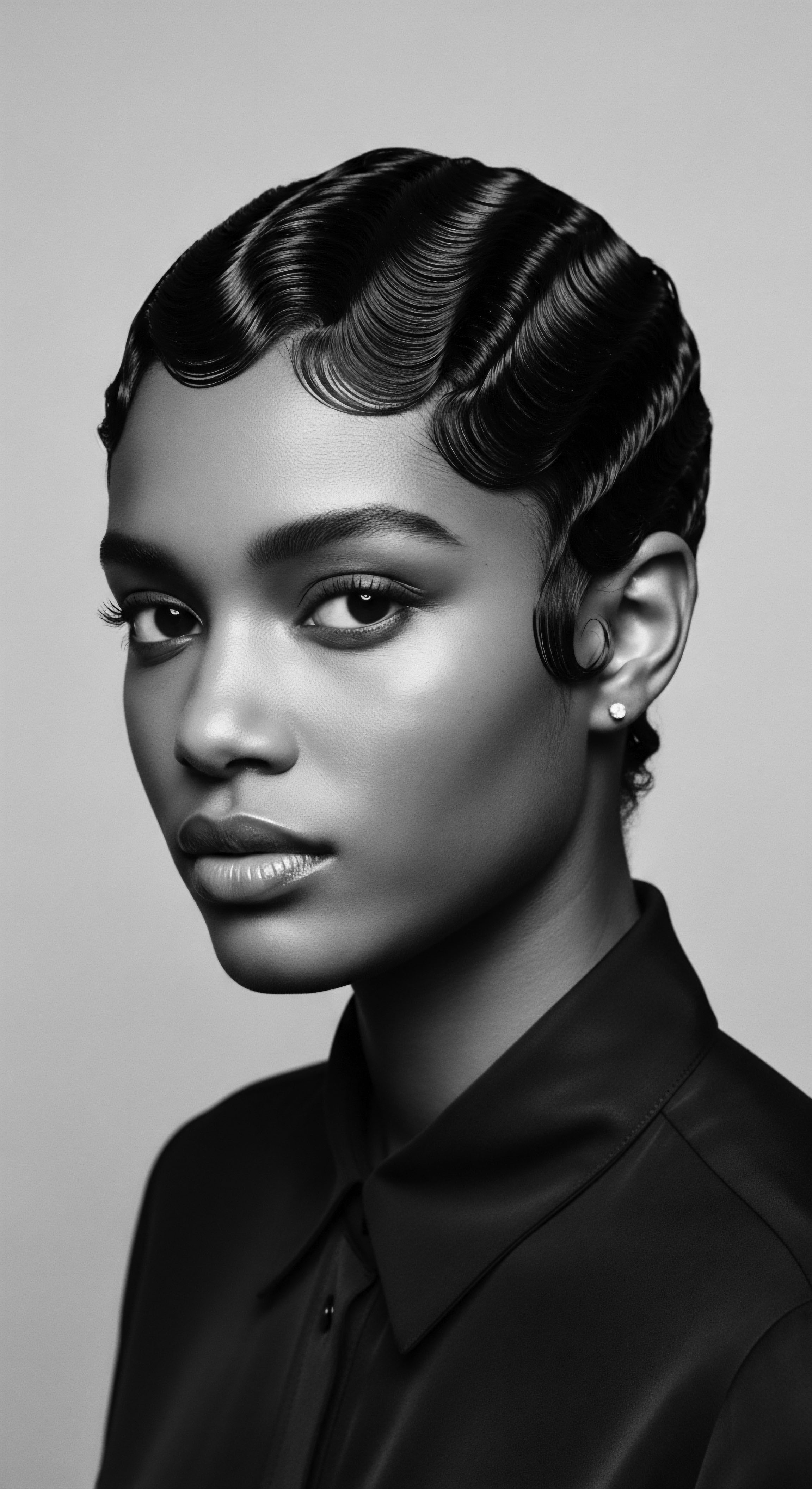
Roots
There exists a quiet dialogue between the strands that crown our heads and the ancestral lands from which we hail. For generations, textured hair, in its myriad coils and curls, has been a vibrant manuscript, recording stories of migration, resilience, and profound ingenuity. It is more than mere keratin and pigment; it is a living heirloom, a tangible link to a heritage stretching back through time, across continents.
Can the ancient whispers held within these strands truly guide our modern routines? Indeed, they offer a profound compass, pointing us towards practices rooted in biological wisdom and cultural reverence.

The Architecture of Textured Hair
At the microscopic level, the inherent characteristics of textured hair begin to tell their story. The unique elliptical shape of the hair follicle, rather than the round cross-section seen in other hair types, dictates the curl pattern. This elliptical shape causes the hair shaft to grow with an inherent bend and twist. Furthermore, the distribution of keratins within the hair shaft, specifically how disulfide bonds are arranged, plays a significant role in its unique structure and curl memory (Khumalo, 2010).
Unlike straight hair, which tends to grow directly out of the scalp, textured strands often grow in a more curved path, coiling upon themselves. This natural spiraling, while creating breathtaking volume and density, also means fewer contact points for natural sebum to travel down the shaft, leading to a predisposition for dryness. Understanding this innate architecture is the first step in honoring its heritage, a knowledge our ancestors intuitively possessed.
Traditional African hair care, long before the advent of modern chemistry, understood this need for moisture. Practices involved the consistent application of natural oils and butters to lubricate the strands and scalp, protecting them from environmental elements and mechanical stress. This ancient wisdom, passed down through generations, recognized the hair’s natural inclination towards dryness and developed regimens to counteract it. For instance, the use of Shea Butter and Palm Oil was not simply for aesthetics; these were deeply moisturizing agents, chosen for their ability to seal in hydration and provide a protective barrier.
The very physiology of textured hair, with its unique coiling pattern, speaks to an ancient wisdom that prioritized moisture and protection, lessons our forebears understood implicitly.

Classification Beyond Modern Typologies
Contemporary hair typing systems, while useful for product selection, often fall short of capturing the true diversity and cultural significance of textured hair. While systems like the Walker Typing system (Type 1-4) categorize hair based on curl pattern, the heritage lens reminds us that traditional classifications were far more intricate, often tied to social status, tribal affiliation, or rites of passage (Sherrow, 2023). Before the imposition of colonial beauty standards, hair was a marker of identity, a visual language understood within communities.
Consider the myriad terms that existed across African societies to describe hair textures and their suitable styles. These were not arbitrary labels; they conveyed deep knowledge about the hair’s properties and how to best care for it. Such indigenous terminologies, though largely unrecorded in Western scientific literature, stand as testaments to a sophisticated understanding of hair biology and its intrinsic connection to cultural life. Embracing these traditional understandings enriches our contemporary approach to classification, moving beyond mere numerical assignment to a deeper appreciation of the hair’s story.
| Aspect of Classification Purpose |
| Ancestral Context Identity marker, social status, spiritual connection, tribal affiliation, age, marital status (Sherrow, 2023). |
| Modern Perspective Product selection, styling guidance, understanding hair properties. |
| Aspect of Classification Methodology |
| Ancestral Context Visual observation, tactile assessment, community knowledge, generational teaching. |
| Modern Perspective Curl pattern typologies (e.g. 1-4), porosity tests, strand analysis. |
| Aspect of Classification Associated Practices |
| Ancestral Context Specific styling techniques for each texture, communal grooming rituals. |
| Modern Perspective Regimen building, ingredient pairing, heat application strategies. |
| Aspect of Classification Cultural Resonance |
| Ancestral Context Deeply embedded in daily life, storytelling, collective memory. |
| Modern Perspective Often divorced from cultural context, focus on individual aesthetics. |
| Aspect of Classification Understanding both historical and modern classifications provides a fuller picture of textured hair's complexities and its place within human heritage. |
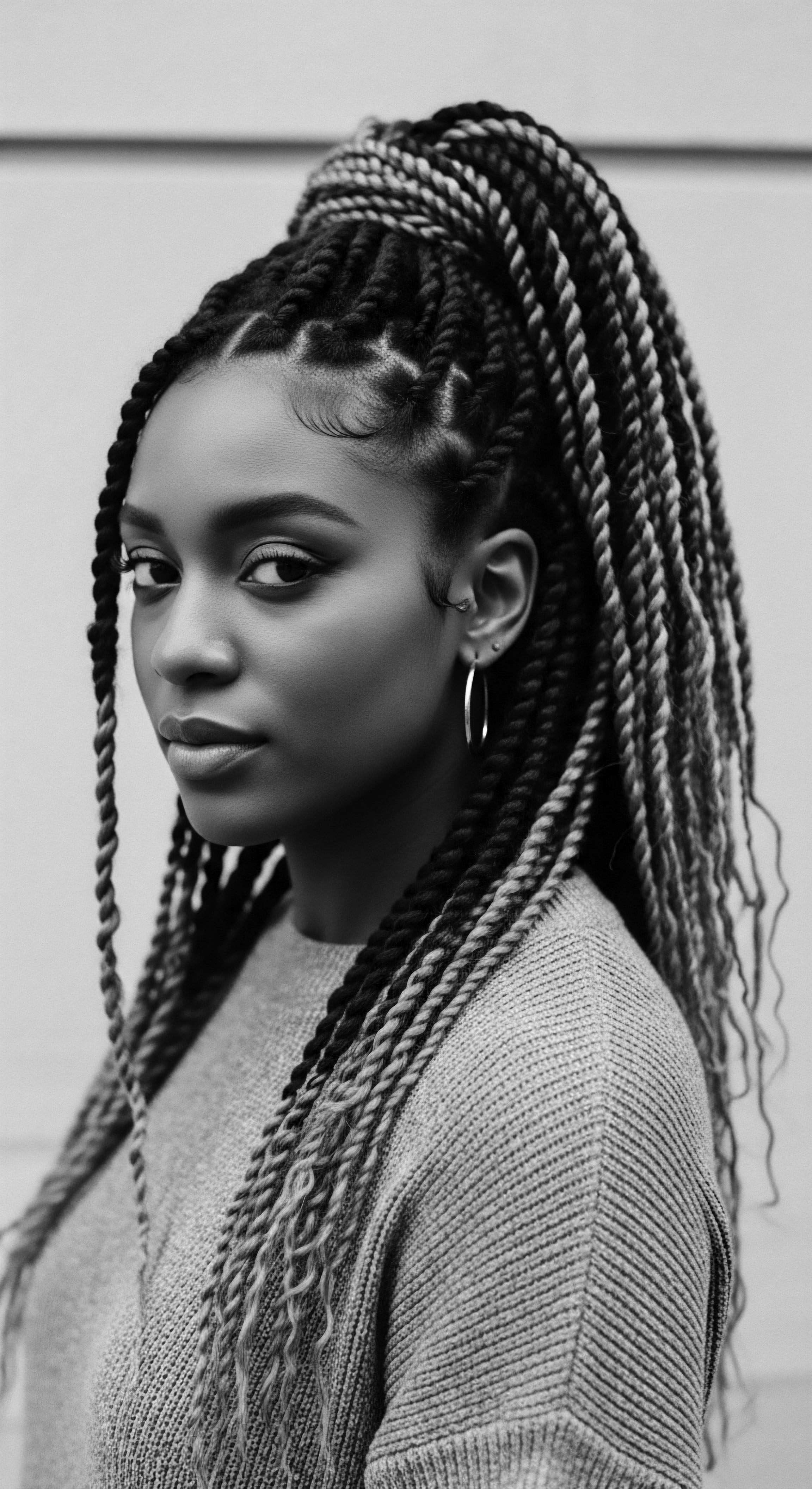
Echoes from the Source ❉ Hair Growth and Environmental Factors
The human hair growth cycle—anagen (growth), catagen (transition), and telogen (rest)—is a universal biological rhythm, yet its expression in textured hair can be subtly influenced by its unique characteristics. While the anagen phase, the period of active growth, can last for several years, textured hair, with its coils and bends, can be more prone to mechanical stress and breakage if not handled with care. This susceptibility informed historical practices that emphasized protective styling, minimizing manipulation to preserve length and health. Our ancestors intuitively understood that retaining length required deliberate care and styles that sheltered the hair.
Environmental factors also played a significant role in shaping historical hair care. In equatorial Africa, where humanity originated, tightly curled hair offered a crucial evolutionary advantage. Research indicates that such hair provides superior protection from the sun’s radiative heat, minimizing the need for the body to expend excess water through sweating for cooling (Lasisi & Jablonski, 2023). This biological adaptation means that textured hair, in its very structure, is a testament to human resilience and environmental attunement.
This deep history reminds us that protective styling is not a modern trend; it is an ancestral imperative, a biological wisdom encoded in our very strands. The historical emphasis on moisture and protection, therefore, was not merely aesthetic, but a direct response to both the hair’s inherent characteristics and the environmental conditions in which it flourished.

Ritual
The hands that braid, twist, and adorn are not simply styling; they are engaging in a ritual, a tender thread connecting present practices to a vibrant past. These acts of care, often performed communally, carry the weight of generations, each knot and section a silent testament to the ingenuity of those who came before us. Can these echoes of historical hair care rituals truly guide our approach to modern styling? They do, offering a blueprint for resilience, beauty, and deep connection to our textured hair heritage.
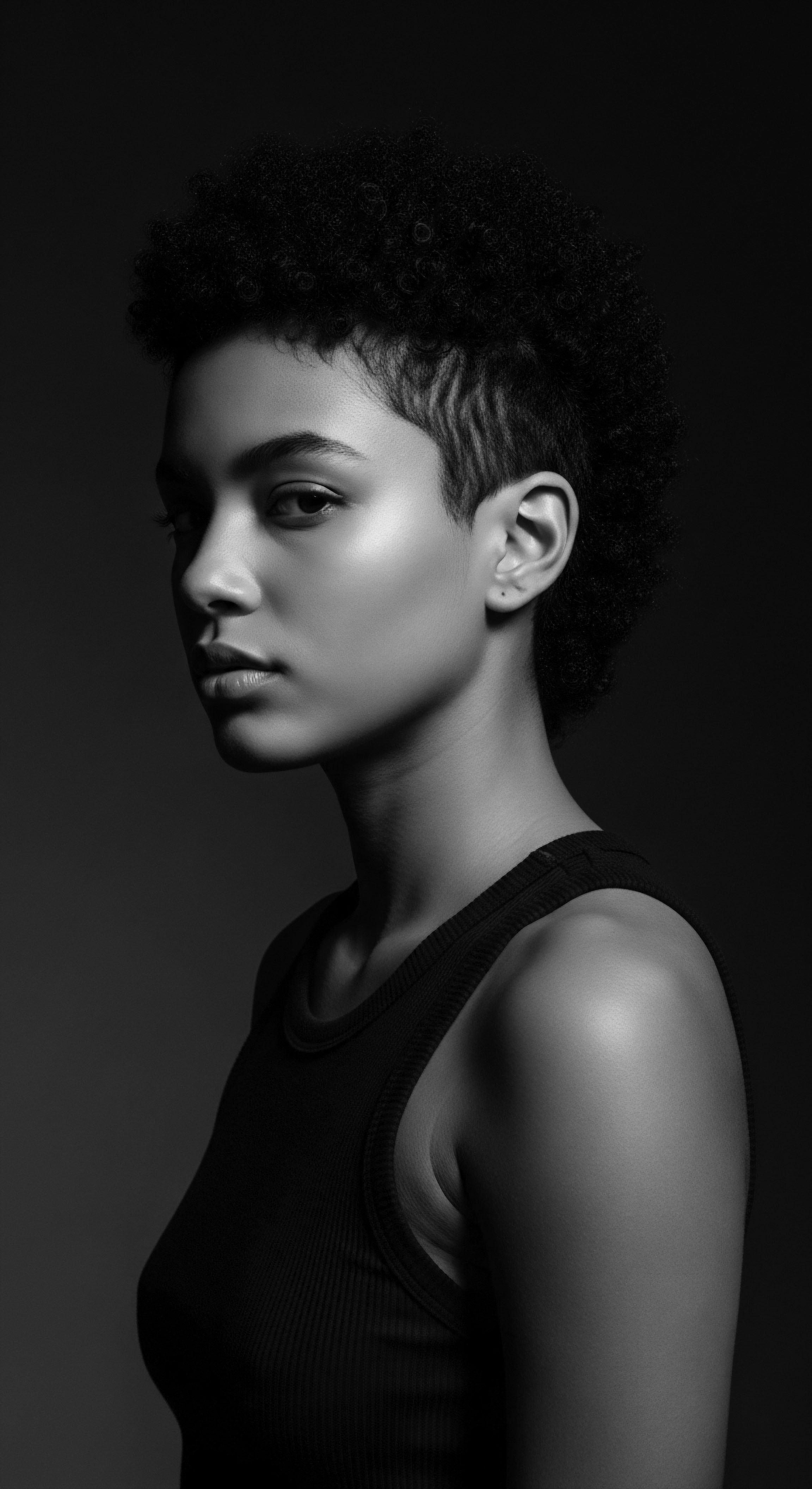
The Ancestral Roots of Protective Styles
Protective styles, which shield the hair from daily manipulation, environmental damage, and excessive pulling, are not a recent innovation. Their origins stretch back millennia in African societies, where they served multifaceted purposes beyond mere aesthetics. Braids, cornrows, and twists were intricate forms of communication, signaling age, marital status, tribal identity, wealth, or religious beliefs (Byrd & Tharps, 2014). These styles were crafted to protect the hair shaft and scalp, allowing for growth and minimizing breakage, a practice that addressed the inherent dryness and delicate nature of textured strands (Roseborough & McMichael, 2009).
During the transatlantic slave trade, the functional aspect of protective styles intensified. Hair became a covert tool for survival and resistance. For instance, Cornrows, known as “kolese” or “irun didi” in Yoruba, were reportedly used in various ways to convey secret messages or even maps for escape routes (Beds SU, 2022).
While direct, tangible evidence remains elusive, the persistence of this oral history speaks volumes about the creative ways enslaved people maintained agency and communicated amidst extreme oppression (Griffins and Ginger Snaps, 2023). This narrative, regardless of its precise historical documentation, underscores the profound significance of hair as a vessel for cultural memory and resilience.
Protective styling, deeply rooted in ancestral practices, served as a means of identity, communication, and preservation for textured hair, a testament to its enduring cultural and practical significance.
The traditional art of braiding involved a communal aspect, fostering bonds and passing down cultural knowledge from one generation to the next (Nyela, 2021). This community care contrasts sharply with modern, often isolated, hair routines. Today’s stylists, particularly those specializing in textured hair, are often inheritors of this traditional knowledge, blending it with contemporary understanding of hair health.
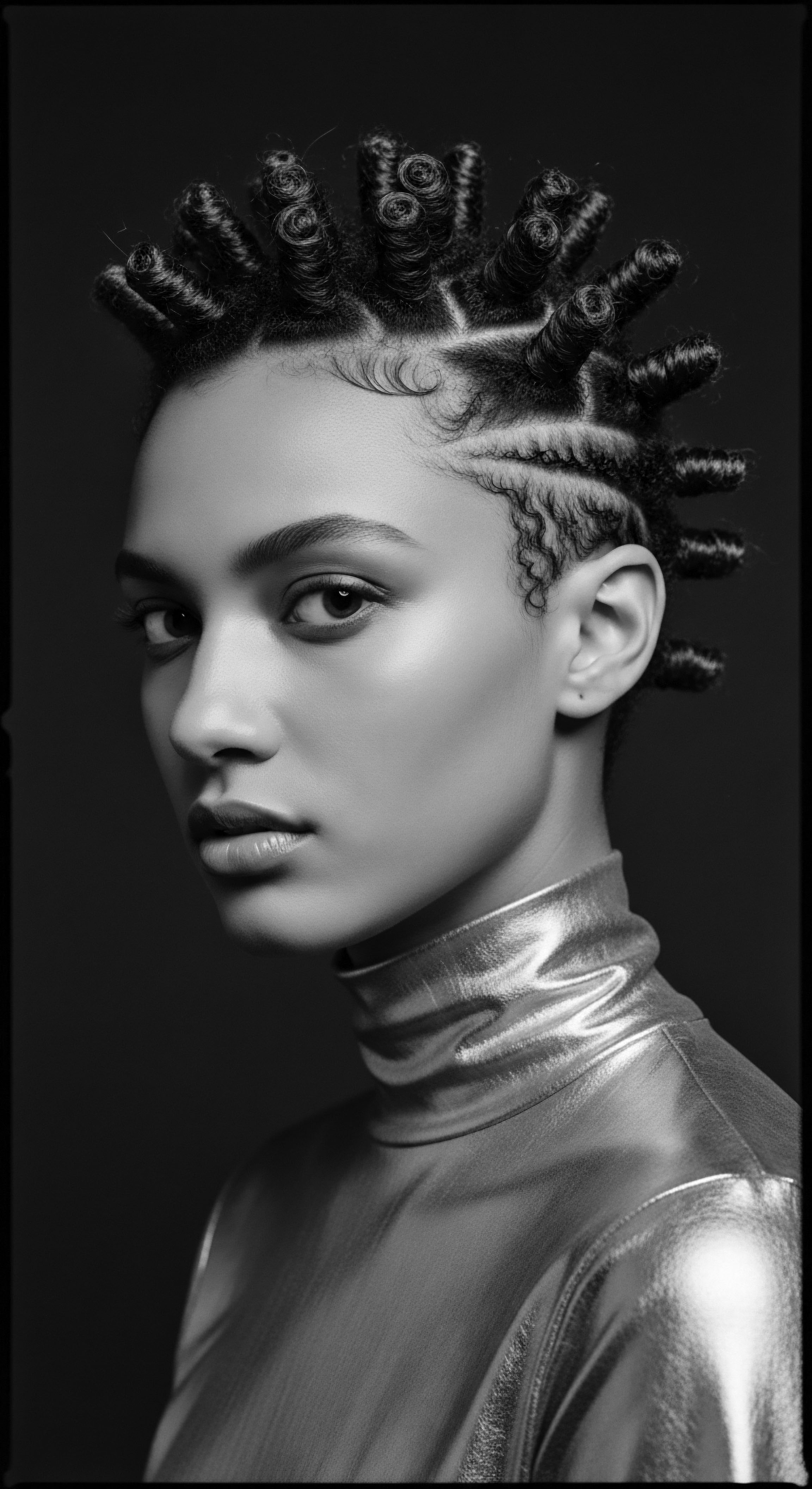
Styling Techniques and Their Enduring Relevance
Many contemporary styling methods for textured hair draw direct lineage from historical practices. The principle remains the same ❉ minimize manipulation, retain moisture, and protect the ends. Here are some examples:
- Coiling ❉ Ancient African societies often used coiling techniques, sometimes with natural fibers or sticks, to create defined coils that protected the hair. Today, finger coiling or comb coiling methods achieve similar definition and protection.
- Twisting ❉ Two-strand twists or three-strand twists were, and still are, effective ways to clump hair strands together, preventing tangles and preserving moisture. These styles served as foundational protective styles for weeks at a time (Roseborough & McMichael, 2009).
- Braiding ❉ From intricate cornrows to standalone box braids or knotless braids, the foundational techniques have remained remarkably consistent over millennia (Genesis Career College, 2023). Modern adaptations may involve adding extensions for length or volume, but the core protective mechanism persists.
The continuity of these techniques highlights their efficacy. The science confirms what ancestral practices intuitively understood ❉ grouping hair strands reduces friction, minimizes exposure to environmental aggressors, and locks in hydration. This continuity of technique across millennia exemplifies the powerful influence of historical practices on modern hair care, providing a heritage-informed foundation for hair health.

Traditional Tools and Their Modern Descendants
The tools used in historical hair care were often simple, yet profoundly effective. These included combs carved from wood or bone, pins made of natural materials, and even specialized needles for intricate braiding. These tools were designed to gently navigate the unique curl patterns of textured hair, minimizing breakage. Modern tools, while technologically advanced, often echo the functionality of their predecessors.
| Traditional Tool Bone/Wood Combs |
| Purpose and Heritage Context Detangling gently, scalp stimulation, used in communal grooming rituals. Their wide-tooth design mimicked natural finger detangling. |
| Modern Equivalent and Link Wide-tooth combs, detangling brushes. Designed to reduce breakage and respect hair's delicate structure. |
| Traditional Tool Fingers/Natural Fibers |
| Purpose and Heritage Context The primary tools for braiding, twisting, coiling, and sectioning. Emphasized delicate, tactile manipulation. |
| Modern Equivalent and Link Finger coiling, sectioning clips, gentle manipulation techniques. |
| Traditional Tool Clay/Ash Pastes |
| Purpose and Heritage Context Used for cleansing, conditioning, and creating temporary hold; often infused with herbs. |
| Modern Equivalent and Link Clay masks, natural styling gels, pre-poo treatments. Focus on natural ingredients and gentle cleansing. |
| Traditional Tool The functionality of traditional tools often aligns with the principles of modern hair care, emphasizing gentle manipulation and protection. |
The heritage of these tools speaks to a deep respect for the hair’s integrity. The patience and skill involved in using traditional tools fostered a mindful approach to hair care, a stark contrast to the rush of contemporary routines. This thoughtful engagement, a cornerstone of ancestral practices, offers a timeless lesson for our current interactions with our hair.

Relay
The legacy of textured hair is not a static artifact of the past; it is a dynamic, living continuum, a relay race of wisdom passed from hand to hand, generation to generation. It is here, in the interplay of ancestral practices, scientific validation, and the ever-shifting landscape of identity, that we truly understand the enduring power of historical protective hairstyles. Can these ancient practices, steeped in cultural memory, truly reshape the contours of our modern hair care routines and beyond?

From Clandestine Maps to Cultural Statements
The narrative of hair as a form of communication is nowhere more starkly demonstrated than during the period of enslavement. While the precise historical documentation remains a subject of ongoing discussion, the oral traditions and folklore regarding Cornrows as a means of covert communication during the transatlantic slave trade are compelling and resonate deeply within Black communities (Nyela, 2021). It is believed that enslaved women, particularly in regions like Colombia with figures such as Benkos Biohó, ingeniously braided patterns into their hair that served as maps, indicating escape routes or containing seeds for future cultivation upon reaching freedom (Beds SU, 2022). This practice, whether literal cartography or symbolic direction, highlights the extraordinary resilience and ingenuity of those who were oppressed.
It underscores how hair, a seemingly personal aspect of being, became a profound tool of survival, identity, and organized resistance (Byrd & Tharps, 2014). The hair, in these instances, held a secret lexicon, a silent language understood only by those for whom freedom was the ultimate destination. This is a powerful case study of hair’s role far exceeding mere aesthetics.
This historical example illustrates the profound cultural significance of protective styles. They were not merely functional; they were imbued with meaning, carrying codes, histories, and aspirations. Today, the choice to wear protective styles, particularly those with deep African roots, stands as a conscious affirmation of heritage, a reclamation of narratives, and a defiance of Eurocentric beauty standards that long marginalized textured hair (Jenkins, 2020).
The Black is Beautiful movement of the 1960s saw natural hairstyles, including braids, become potent symbols of Black pride, a rejection of assimilation, and a visible connection to African ancestry (Jenkins, 2020). This cultural and political weight continues to inform modern choices, making protective styles a powerful statement of identity and celebration.
The historical use of cornrows as covert communication during enslavement underscores the profound role of protective styles as vessels of resilience and cultural knowledge, extending their influence far beyond aesthetics into matters of survival and identity.
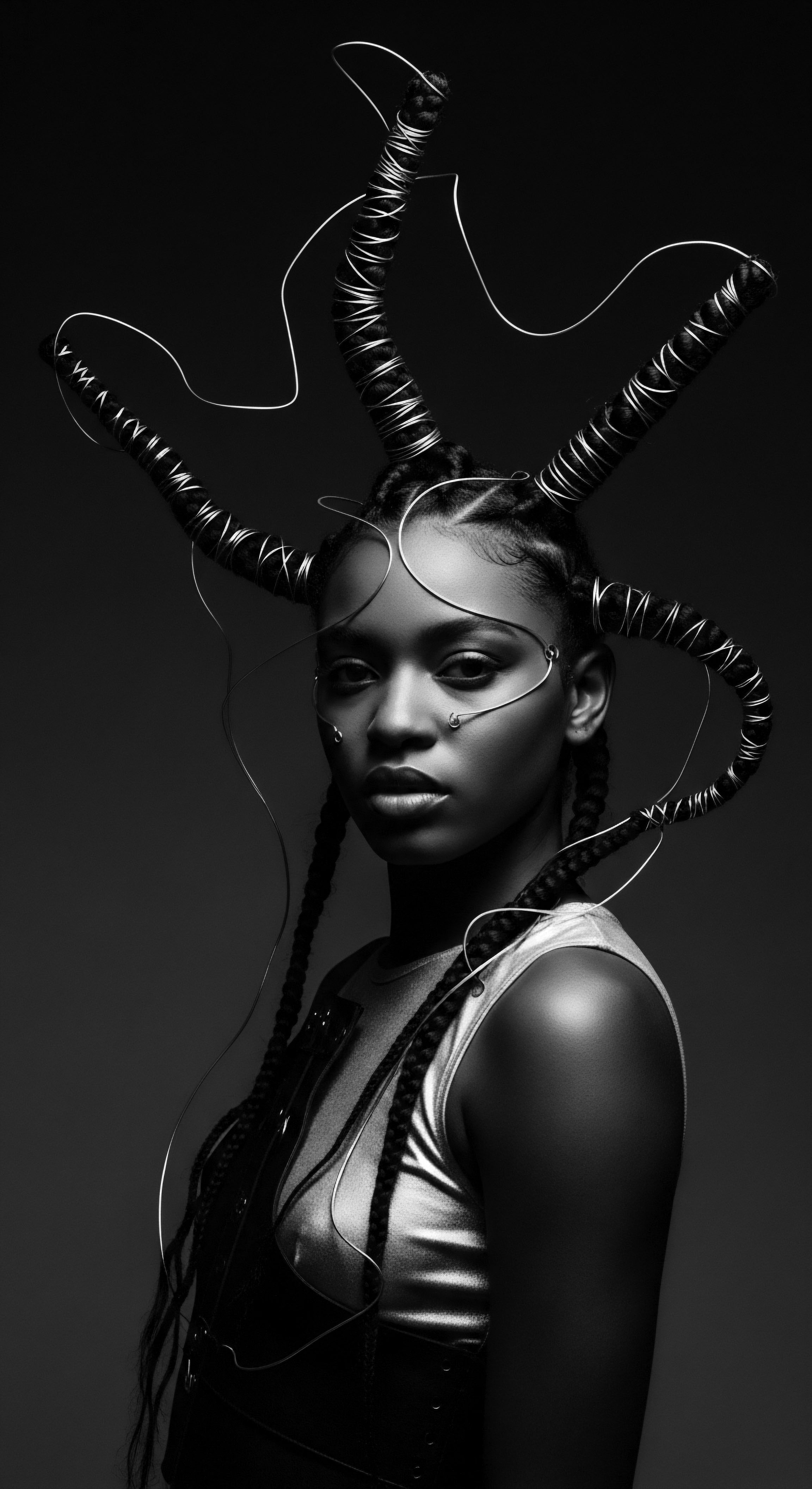
Scientific Validation of Ancestral Regimens
Modern hair science, in many instances, offers validation for the long-standing practices of our ancestors. Textured hair, with its unique structural properties, benefits immensely from practices that minimize manipulation and maximize moisture. Research confirms that Afro-textured hair is inherently more prone to mechanical damage and breakage due to its elliptical cross-section and the distribution of disulphide bonds compared to other hair types (Khumalo et al. 2010).
This susceptibility to breakage means that approaches minimizing daily combing, brushing, and environmental exposure are crucial for length retention and overall hair health (Roseborough & McMichael, 2009). Protective styles directly address this need.
Furthermore, the focus on natural ingredients in traditional hair care aligns with contemporary understanding of scalp and hair health. Natural oils, butters, and herbs—long used in African practices—provide essential lipids and nutrients that supplement the hair’s natural sebum, which often struggles to coat the entire length of tightly coiled strands. Studies have shown that emollients like shea butter and coconut oil can reduce protein loss and prevent hygral fatigue, the swelling and shrinking of hair as it gains and loses moisture, which can weaken the strand (Asbeck et al.
2022). This scientific backing strengthens the argument for integrating ancestral ingredient knowledge into modern routines, moving beyond synthetic formulations to honor the efficacy of nature’s bounty.
The concept of minimal manipulation, inherent in protective styles, is a direct counter to practices that historically caused damage. The prevalence of Central Centrifugal Cicatricial Alopecia (CCCA) among Black women has been linked to both chemical relaxants and certain traction styles (Asbeck et al. 2022). This underscores the critical role of choosing protective styles that are not too tight and are not worn for excessive durations, a modern interpretation of the ancestral wisdom to handle textured hair with care and respect.

Hair as a Cultural Repository
Hair, particularly textured hair, functions as a living archive, a repository of cultural memory and inherited wisdom (Nyela, 2021). The practice of hair grooming, traditionally a communal activity, served as a means of transmitting social norms, aesthetic values, and practical knowledge from elders to younger generations (Byrd & Tharps, 2014). This intergenerational sharing created a continuity of care, a tender link across time that ensured the survival of traditions despite external pressures.
The ritual of braiding, for instance, became a space for storytelling, for learning, and for strengthening communal bonds. The very act of caring for textured hair, then, is a form of oral history, a tactile way of remembering and honoring those who came before.
The global phenomenon of the natural hair movement is a contemporary manifestation of this deep cultural connection. It is a collective turning back to ancestral practices, not out of nostalgia, but out of a renewed understanding of hair health, cultural pride, and self-acceptance. The rediscovery of protective styles, the celebration of natural textures, and the embracing of traditional ingredients represent a conscious choice to align modern routines with a rich and enduring heritage. This alignment provides not only physical benefits for the hair but also profound psychological and cultural affirmation, connecting individuals to a larger tapestry of identity and resilience.

Reflection
The journey through the intricate world of textured hair, from its very roots in biology to its profound cultural expressions, reveals a truth that transcends mere aesthetics. Our hair, in its glorious coils and captivating patterns, is a living, breathing archive, a testament to the enduring human spirit and the deep wisdom of our ancestors. Can the historical protective hairstyles of textured hair truly influence modern routines?
They do more than influence; they serve as a profound foundation, a vibrant echo that continues to shape our present and guide our future. They whisper tales of survival, of identity, and of unwavering beauty.
The Soul of a Strand ethos invites us to perceive each hair filament not as an isolated entity, but as a component of a grand, interconnected narrative. It reminds us that the quest for healthy, thriving textured hair is not solely a scientific pursuit or a beauty trend; it is an act of reclamation, a conscious honoring of a lineage rich with ingenuity and strength. When we choose protective styles, when we seek out nourishing ingredients, when we share knowledge within our communities, we are not simply tending to our physical appearance.
We are participating in a timeless ritual, a conversation with generations past, ensuring that the legacy of textured hair continues to flourish. This continuing conversation, this living library, ensures that the deep wisdom embedded in our hair’s heritage remains a guiding light, perpetually influencing how we care for and celebrate our hair today and for all tomorrows.

References
- Asbeck, S. Riley-Prescott, C. Glaser, E. & Tosti, A. (2022). Afro-Ethnic Hairstyling Trends, Risks, and Recommendations. Cosmetics, 9(1), 17.
- Beds SU. (2022, October 7). Black History Month 2022 ❉ The History Behind Cornrows. University of Bedfordshire Students’ Union.
- Byrd, A. D. & Tharps, L. L. (2014). Hair Story ❉ Untangling the Roots of Black Hair in America. St. Martin’s Griffin.
- Genesis Career College. (2023, May 23). The History Of Black People Braiding Their Hair.
- Griffins and Ginger Snaps. (2023, March 22). Were Cornrows Used by Enslaved People to Escape Slavery?.
- Jenkins, N. D. (2020). Strands of Identity ❉ The Cultural Influence and Sociopolitical Role of Natural Hair. (Unpublished doctoral dissertation). University of San Francisco.
- Khumalo, N. P. et al. (2010). ‘Relaxers’ damage hair ❉ Evidence from amino acid analysis. Journal of the American Academy of Dermatology, 62, 402–8.
- Lasisi, S. & Jablonski, N. (2023, June 7). Curly hair kept early humans cool. Penn State University.
- Nyela, O. (2021). Braided Archives ❉ Black hair as a site of diasporic transindividuation. (Master’s thesis). York University.
- Roseborough, I. E. & McMichael, A. J. (2009). Hair Care Practices in African-American Patients. Seminars in Cutaneous Medicine and Surgery, 28(2), 103–108.
- Sherrow, V. (2023). Hair Style ❉ A to Z. Infobase Publishing. (Cited in The Hermeneutics of Hair Braiding ❉ The Expertise Associated with Black Hairstyling).
